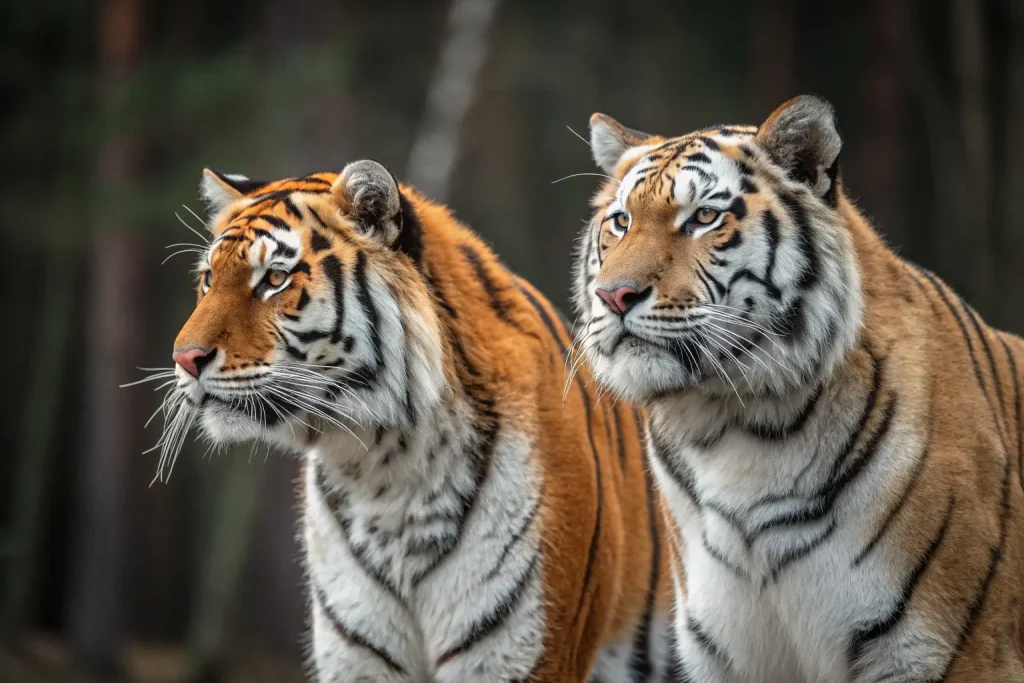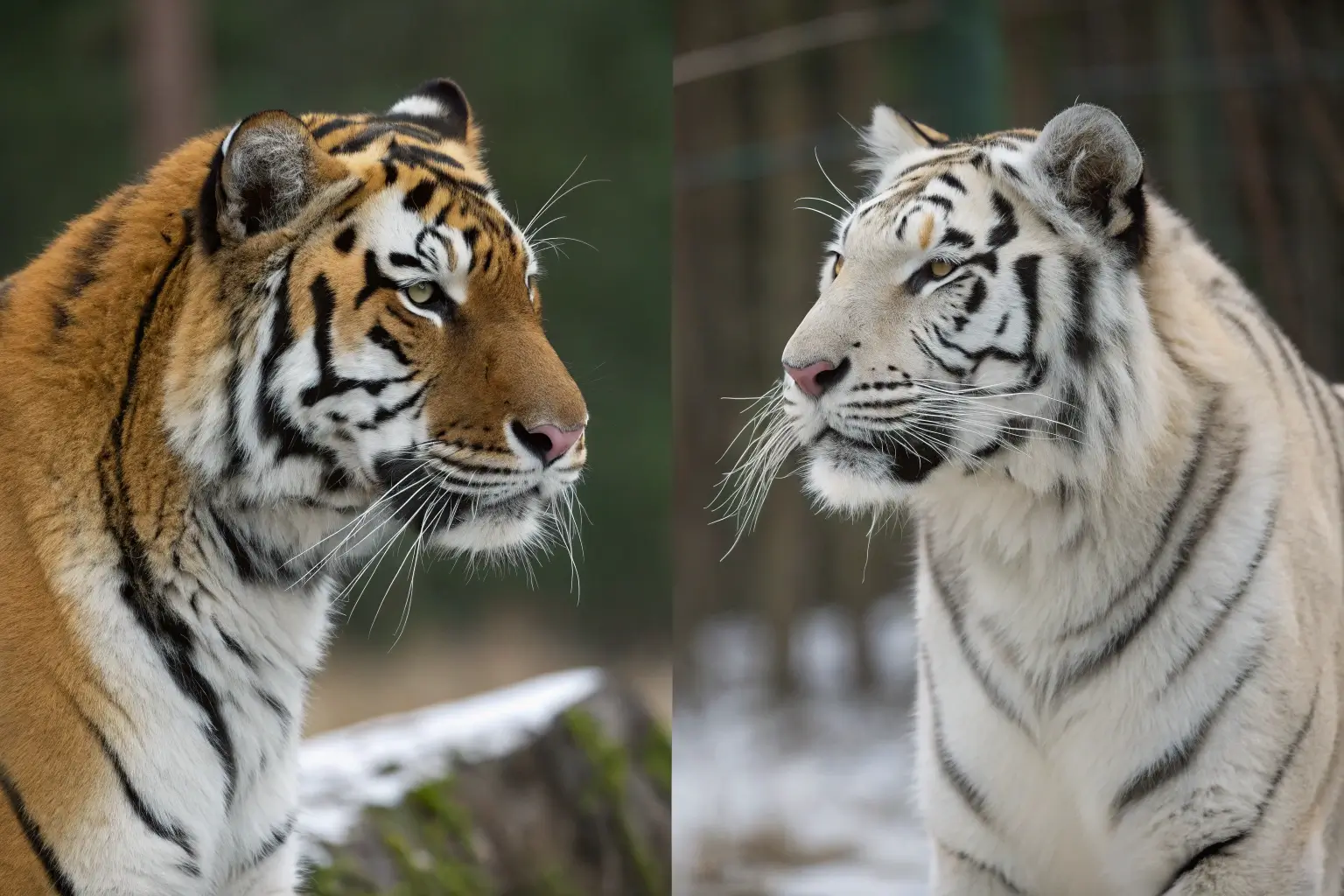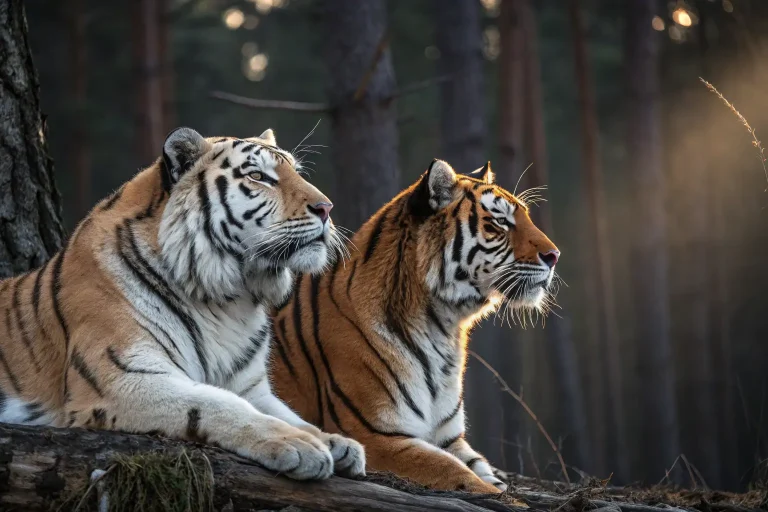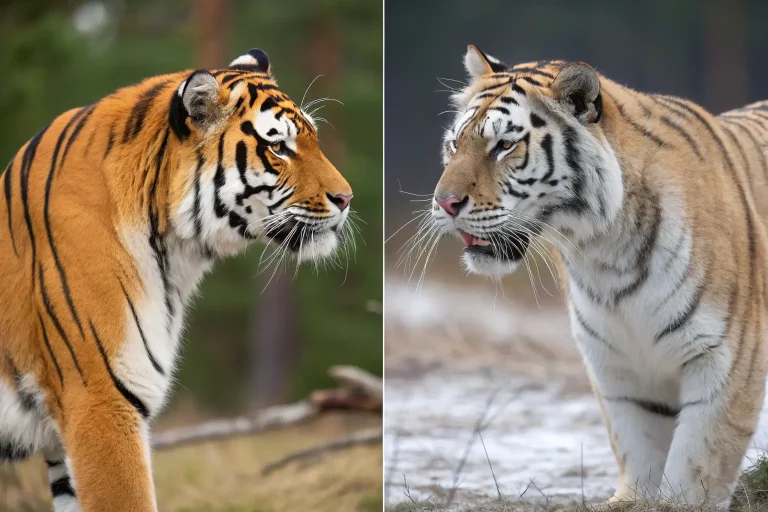Siberian vs Bengal Tiger: 7 Key Differences Revealed!
Are you fascinated by majestic big cats? The bengal tiger versus siberian tiger comparison reveals fascinating differences between two of nature’s most magnificent predators. While both share the iconic orange and black striped appearance, these apex predators have evolved distinct characteristics that set them apart in surprising ways. From their physical adaptations to behavioral traits, understanding these differences offers valuable insights for wildlife enthusiasts and conservation advocates alike.
Introduction
The tiger (Panthera tigris) stands as one of nature’s most perfect predators – powerful, stealthy, and breathtakingly beautiful. Among the remaining tiger subspecies, the Bengal tiger and the Siberian tiger reign as the most well-known and studied. While they may appear similar at first glance, the bengal tiger versus siberian tiger comparison reveals fascinating adaptations that have evolved in response to dramatically different environments.
Tigers face unprecedented threats across their range, making it critically important to understand their unique characteristics and needs. By appreciating the distinct adaptations of each subspecies, we gain valuable insights that can inform conservation strategies and help preserve these magnificent creatures for future generations.
Did you know that despite being the same species, a Bengal tiger transported to Siberia would likely perish within weeks, while a Siberian tiger in the jungles of India would suffer from dangerous overheating? Such is the remarkable specialization of these big cats to their native environments.
Species Overview
Scientific Name
Both tigers belong to the species Panthera tigris, but represent different subspecies:
- Bengal tiger: Panthera tigris tigris
- Siberian tiger: Panthera tigris altaica (also known as the Amur tiger)
In the bengal tiger versus siberian tiger classification, both belong to the family Felidae and the genus Panthera, which includes other big cats like lions, jaguars, and leopards.
Physical Characteristics
The physical differences between Bengal and Siberian tigers represent their first major distinction:
Size and Weight:
- Siberian tigers are generally larger, with males weighing 400-675 pounds (180-306 kg) and measuring up to 10.5 feet (3.3 m) in length
- Bengal tigers typically weigh 350-550 pounds (159-249 kg) with a length of about 9 feet (2.7 m)
Coat and Coloration:
- Bengal tigers display a vivid orange coat with dark brown or black stripes
- Siberian tigers feature a paler, more yellowish-orange coat with fewer, more widely spaced stripes
- Siberian tigers develop a thicker winter coat with a prominent ruff around the neck and longer fur overall
Physical Adaptations:
- Siberian tigers have smaller ears (reducing heat loss), more facial fat (insulation), and larger paws (functioning like snowshoes)
- Bengal tigers have sleeker builds optimized for stealth and agility in dense jungle environments
Subspecies
The bengal tiger versus siberian tiger comparison represents just two of the remaining six tiger subspecies:
- Bengal (Indian) tiger
- Siberian (Amur) tiger
- Sumatran tiger
- South China tiger
- Malayan tiger
- Indochinese tiger
Three additional subspecies (Bali, Javan, and Caspian tigers) have gone extinct in the past century, highlighting the urgent conservation challenges facing these magnificent animals.
Habitat and Distribution
Natural Habitat
Bengal Tiger:
- Thrives in tropical and subtropical environments
- Inhabits diverse ecosystems including mangrove swamps, moist evergreen forests, dry deciduous forests, and grasslands
- Requires access to water, adequate cover, and sufficient prey populations
- Adaptable to various elevations from sea level to the Himalayan foothills
Siberian Tiger:
- Survives in some of the harshest climatic conditions of any large predator
- Lives primarily in temperate broadleaf, mixed, and boreal forests
- Prefers mountainous regions with dense forest cover
- Requires large territories due to lower prey density
This dramatic habitat difference in the bengal tiger versus siberian tiger comparison has driven many of their evolutionary adaptations.
Geographic Range
Bengal Tiger:
- Primarily found in India (which hosts approximately 70% of the world’s wild tigers)
- Also present in Bangladesh, Nepal, and Bhutan
- Small populations may exist in Myanmar
- Historically ranged across much of the Indian subcontinent
Siberian Tiger:
- Mainly concentrated in Russia’s Far East (Primorsky and Khabarovsk regions)
- Small populations in northeastern China
- Possibly a few individuals in North Korea
- Once ranged throughout northeastern China, the Korean Peninsula, and eastern Russia
Adaptations
The bengal tiger versus siberian tiger adaptation differences are profound:
Bengal Tiger Adaptations:
- Excellent swimmers adapted to mangrove ecosystems
- Higher heat tolerance
- Shorter, sleeker coat for better cooling in hot environments
- Specialized hunting techniques for diverse prey species
- Ability to thrive in relatively close proximity to human settlements
Siberian Tiger Adaptations:
- Cold-resistant features including thicker fur, layer of fat, and compact extremities
- Larger body size (Bergmann’s rule) providing better heat conservation
- Snow-compatible paws acting as natural snowshoes
- Seasonal behavior changes including increased fat storage before winter
- Specialized hunting techniques for larger prey
Diet and Feeding Habits
What They Eat
In the bengal tiger versus siberian tiger diet comparison, we see adaptations to local prey availability:
Bengal Tiger Diet:
- Primarily feeds on large ungulates like sambar deer, chital, gaur, and water buffalo
- Also hunts wild boar, nilgai antelope, and occasionally smaller prey
- May take domestic livestock when natural prey is scarce
- Occasionally preys on other predators including leopards and small bears
Siberian Tiger Diet:
- Relies heavily on red deer, sika deer, and wild boar
- Also hunts moose, musk deer, and Manchurian wapiti
- Will take smaller prey including salmon during spawning seasons
- Occasionally targets young brown bears or Asiatic black bears
Hunting or Foraging Behavior
Both subspecies are ambush predators, but with distinct approaches:
Bengal Tiger Hunting:
- Uses dense vegetation for cover when stalking prey
- Often hunts at night in regions with human disturbance
- Relies on stealth up to the final rush, which rarely exceeds 65 feet
- May patrol established trails to intercept prey
- Uses water bodies and swims comfortably to pursue prey
Siberian Tiger Hunting:
- Employs snow as strategic cover
- Tracks prey over longer distances in the sparse forest
- Can silently stalk potential meals for miles
- Demonstrates remarkable patience, sometimes waiting hours before striking
- Shows specialized techniques for taking down larger, more dangerous prey
Dietary Needs
The bengal tiger versus siberian tiger comparison reveals different caloric requirements:
- An adult Siberian tiger requires roughly 9-10 kg (20-22 pounds) of meat daily to maintain condition
- Bengal tigers generally need slightly less, approximately 7-8 kg (15-18 pounds) daily
- Both subspecies gorge when successful (up to 40-60 pounds in one meal)
- Siberian tigers must often endure longer periods between successful hunts
- Both can fast for days when necessary, but Siberians have evolved greater metabolic efficiency
Behavior and Social Structure
Social Behavior
Despite their differences, the bengal tiger versus siberian tiger social behavior follows similar patterns:
- Both are predominantly solitary animals
- Adult tigers maintain exclusive territories marked with scent, scrapes, and visual signals
- Male territories typically overlap with several females
- Temporary aggregations may form around abundant prey or during mating
- Female offspring may establish territories adjacent to their mothers
However, subtle differences exist:
- Siberian tigers generally maintain larger territories (up to 1,000 square kilometers for males)
- Bengal tigers, particularly in prey-rich areas, may have more compact ranges
- Siberian tigers show less tolerance for territorial overlap due to scarcer resources
- Both exhibit “time-sharing” behavior at kills, but Bengals may occasionally share meals
Communication
Both subspecies use similar communication methods with slight variations:
Vocalizations:
- Roars (audible up to 3 miles away)
- Growls, grunts, and hisses
- “Prusten” or chuffing sounds for non-threatening encounters
- Siberian tigers have slightly deeper vocalizations on average
Scent Marking:
- Urine spraying combined with anal gland secretions
- Claw marking on trees
- Feces left in prominent locations
- Siberian tigers rely more heavily on scent marking due to lower population density
Body Language:
- Ear position, whisker movement, and tail signals
- Facial expressions including the “flehmen response”
- Submissive postures during territorial disputes or mating
Mating and Reproduction
The bengal tiger versus siberian tiger reproductive biology shows some notable differences:
Mating System:
- Both are polygynous, with males mating with multiple females
- Females typically reproduce every 2-3 years
- Estrus lasts 3-7 days, with mating occurring multiple times
- Gestation period is 93-112 days
Reproductive Timing:
- Bengal tigers can breed year-round with slight peaks
- Siberian tigers typically mate in winter with cubs born in spring
Litter Size and Development:
- Bengal tigers: 2-4 cubs per litter
- Siberian tigers: 2-3 cubs per litter (lower average)
- Siberian cubs develop thicker fur earlier
- Survival rates generally higher for Bengal cubs (approximately 60% vs. 40%)
- Both remain with their mother for 18-24 months
Conservation Status

Endangerment Level
The bengal tiger versus siberian tiger conservation status reflects their precarious situation:
- Both subspecies are listed as Endangered on the IUCN Red List
- Current wild population estimates (2023):
- Bengal tigers: 2,967-3,400
- Siberian tigers: 480-540
- Both have experienced over 90% population decline in the past century
- Bengal tigers are showing recovery in some areas due to intensive conservation
- Siberian tigers have stabilized but remain at critically low numbers
Threats
While facing similar categories of threats, the specific challenges differ:
Bengal Tiger Threats:
- Extreme habitat fragmentation and loss
- Human-tiger conflict due to high human population density
- Poaching for traditional medicine markets
- Prey depletion through overhunting
- Genetic isolation of small populations
Siberian Tiger Threats:
- Poaching remains the primary threat
- Logging and infrastructure development
- Climate change affecting habitat and prey distribution
- Genetic bottlenecks from historically low population
- Disease transmission from domestic animals
Conservation Efforts
The bengal tiger versus siberian tiger conservation approaches share common elements but with regional adaptations:
Bengal Tiger Conservation:
- Project Tiger (India): Established protected reserves since 1973
- Transboundary cooperation between India, Nepal, and Bangladesh
- Wildlife corridors to connect isolated populations
- Community-based conservation with economic incentives
- Anti-poaching patrols and improved enforcement
Siberian Tiger Conservation:
- Russian-Chinese cooperation on transboundary protection
- Land of the Leopard National Park and other protected areas
- Anti-poaching brigades with specialized training
- Prey recovery programs
- Scientific monitoring using camera traps and GPS collars
Interesting Facts
In the fascinating bengal tiger versus siberian tiger comparison, both subspecies boast remarkable characteristics:
Genetic Legacy: The Siberian tiger represents the closest living relative to the extinct Caspian tiger, while Bengal tigers carry genes from three ancestral tiger lineages.
Swimming Abilities: While both can swim, Bengal tigers are truly exceptional swimmers, capable of covering up to 20 miles in water and regularly hunting in mangrove forests.
Temperature Extremes: Siberian tigers can survive in temperatures as low as -45°F (-43°C), while Bengal tigers often hunt in sweltering heat exceeding 120°F (49°C).
Stripe Patterns: Every tiger’s stripe pattern is unique (like human fingerprints), but Siberian tigers have approximately 25% fewer stripes than Bengals.
Cultural Significance: The Bengal tiger is India’s national animal and features prominently in Hindu mythology, while the Siberian tiger holds sacred status among indigenous Siberian peoples like the Udege and Nanai.
Historical Range: Historically, Bengal and Siberian tigers’ ranges were separated by nearly 2,000 miles, preventing natural hybridization in the wild.
Predatory Specialization: Siberian tigers are one of the few predators that regularly hunt brown bears, while Bengal tigers occasionally prey on sloth bears and leopards.
Roar Differences: While both roar powerfully, the Siberian tiger’s roar can travel farther in the cold, dense air of its habitat, reaching distances up to 3-5 miles.
Tips for Caring for the Animal
Neither the Bengal tiger nor the Siberian tiger can be legally or ethically kept as pets. However, here’s what responsible zoos and wildlife facilities consider in the bengal tiger versus siberian tiger care requirements:
Housing Requirements:
- Bengal tigers need warm environments with swimming opportunities
- Siberian tigers require larger spaces with thermal gradient options
- Both need enrichment features like climbing structures and hiding places
- Facilities must provide private denning areas away from public view
Dietary Considerations:
- Specialized nutritional programs including whole carcass feeding
- Bengal tigers typically receive 15-18 pounds of meat daily
- Siberian tigers require 18-25 pounds daily with higher fat content
- Both need regular fasting days to mimic natural feeding patterns
Health Management:
- Different preventative care protocols based on subspecies-specific vulnerabilities
- Bengal tigers are more susceptible to certain parasitic infections
- Siberian tigers often require joint and dental monitoring
- Both need protection from diseases that have emerged in captivity
Role in the Ecosystem
Ecological Importance
The bengal tiger versus siberian tiger ecological function reveals their roles as umbrella species:
Bengal Tiger Ecosystem Impact:
- Controls populations of herbivores like deer and wild boar
- Prevents overgrazing and maintains plant diversity
- Creates “landscapes of fear” that change prey behavior and distribution
- Leaves kills that support scavenger communities
- Indirectly protects watersheds by maintaining ecosystem balance
Siberian Tiger Ecosystem Impact:
- Regulates ungulate populations in temperate and boreal forests
- Prevents overbrowsing of young trees, supporting forest regeneration
- Controls mesopredator (mid-sized predator) populations
- Contributes to nutrient cycling through kill remains
- Acts as an indicator species for forest health
Impact of Decline
The potential consequences of tiger loss differ between regions:
Without Bengal Tigers:
- Explosion of deer and wild boar populations
- Increased crop damage and human-wildlife conflict
- Cascading effects on vegetation structure and diversity
- Loss of charismatic species driving ecotourism
- Reduced incentives for protecting large forest tracts
Without Siberian Tigers:
- Ungulate population irruptions damaging forest regeneration
- Increased pest outbreaks due to ecosystem imbalance
- Loss of evolutionary pressure on prey species
- Diminished cultural and spiritual significance for indigenous communities
- Reduced international focus on protecting Far Eastern forests
Conclusion
The bengal tiger versus siberian tiger comparison reveals how evolution has perfectly adapted these magnificent cats to dramatically different environments. Despite sharing the same species classification, their distinctions in size, coloration, behavior, and physiological adaptations highlight nature’s remarkable capacity for specialization.
Both subspecies face serious threats to their survival, though recent conservation successes offer hope. For the Bengal tiger, protected reserves and improved anti-poaching measures have allowed populations to stabilize and even increase in some regions. Siberian tigers have benefited from enhanced international cooperation and stricter habitat protection.
As apex predators and umbrella species, saving these tigers means protecting entire ecosystems and countless other species. By supporting tiger conservation through donations, responsible tourism, or simply spreading awareness, each of us can contribute to ensuring these magnificent cats continue to roam the wild for generations to come.
What actions will you take to help protect these irreplaceable icons of the wild? Whether supporting organizations like the World Wildlife Fund, choosing sustainable products that don’t contribute to habitat destruction, or educating others about tiger conservation, your contribution matters in the fight to save these remarkable predators.
Frequently Asked Questions
Which is bigger: Bengal tiger or Siberian tiger?
The Siberian tiger is consistently larger than the Bengal tiger. Adult male Siberians typically weigh 400-675 pounds (180-306 kg) compared to Bengal males at 350-550 pounds (159-249 kg). This size difference reflects Bergmann’s rule, which states that animals in colder climates tend to be larger to conserve body heat.
Could a Bengal tiger survive in Siberia?
No, a Bengal tiger would struggle to survive in Siberia’s harsh winter conditions. Without the Siberian tiger’s adaptations like thicker fur, subcutaneous fat layer, smaller ears, and larger paws that function as snowshoes, a Bengal tiger would likely suffer from hypothermia and starvation.
Which tiger subspecies is more endangered?
While both are endangered, the Siberian tiger faces a more precarious situation with only 480-540 individuals remaining in the wild compared to approximately 3,000 Bengal tigers. However, Bengal tigers face more intense habitat fragmentation and human conflict issues due to higher human population density in their range.
Can Bengal and Siberian tigers interbreed?
Yes, Bengal and Siberian tigers can interbreed and produce fertile offspring since they belong to the same species, Panthera tigris. However, this rarely occurs in the wild due to geographic separation. In captivity, hybridization is generally discouraged by responsible breeding programs to maintain the genetic distinctiveness of each subspecies.
Which tiger has a stronger bite force?
Siberian tigers generally have a stronger bite force due to their larger size and skull structure. A Siberian tiger’s bite can exert approximately 1,000 pounds of pressure per square inch (PSI), compared to a Bengal tiger’s 900-950 PSI. For comparison, a lion’s bite force is around 650 PSI and a human’s is about 150-200 PSI.
Do Bengal and Siberian tigers have different hunting strategies?
Yes, their hunting techniques differ based on their environments. Bengal tigers often use dense vegetation for cover and are excellent at stalking in complex environments. Siberian tigers frequently track prey over longer distances in more open forests and have developed specialized techniques for taking down larger prey like adult moose in deep snow conditions.
Which tiger subspecies is more aggressive toward humans?
Neither subspecies is inherently more aggressive toward humans. Tiger attacks typically occur due to habitat encroachment, prey depletion, or injury/illness that prevents normal hunting. Historically, both subspecies have included individual “man-eaters,” though such behavior is extremely rare relative to tiger populations.





